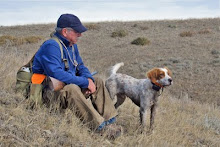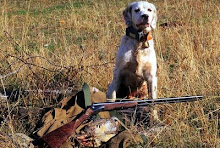I am posting this contribution from Roy Pool of Arizona to make everyone aware of the fragile nature of our Mearn's quail populations. As always, game species management has a lot of stakeholders - hunters, land owners, grazers, and local, state and federal government agencies. Food for thought and a warning.
For years, those of us who live in or near Mearn's quail country have been frustrated with the Arizona Game and Fish Department's lack of response to the ebbs and flows of Mearn's quail populations. The feeling of most long time Mearn's quail hunters is that AzG&F does nothing to manage the resource - and that is the best that can be said of the Department concerning Mearn's quail. The worst that is said, and said often, is that AzG&F is ruled by marketers that promote Mearn's quail hunting to such an extent that the resource is threatened with extirpation in the best areas. The Department, its detractors say, ignores the advice of biologists that base their recommendations on solid in-the-field science, focusing instead on an effort to attract non-resident hunter dollars to the state.
In December 2009, I realized that Mearn's quail were in trouble. There was a monsoon failure that year and Mearn's quail reproduction was near zero in most of the best places that Mearn's quail are found in the USA. If you knew where to go and had good dogs, you could still find 6 or 7 coveys in a day's hunting but all the coveys - I hesitate to call them that - were pairs or 3-4 birds, all adults. Although the failure of the summer rains meant very low grass production in most areas, there was no reduction in grazing allotments in the National Forests where most Mearn's quail are found. Consequently, most of us expected a lower than usual over-winter survival of Mearn's quail and we braced ourselves for another poor season this year.
In June or July of 2010 - I'll have to look up the date - I reported a shocking dearth of quail found when I took a friend to the two best canyons there are in Mearn's quail country - and believe me, I know every canyon there is down here. I told him that I expected to find far fewer quail than in average years, but we'd find some, at least 10 pairs, with the help of my very experienced dogs. We found none at all, zero, no tracks, no scratchings, no sign at all. Something was terribly wrong in Mearn's quail country.
Well, with the help of another Mearn's hunter I found out what was wrong. He sent me an abstract from a wildlife biologist's Ph.D. dissertation. This biologist's research study is Mearn's quail ecology and his study area is in the heart of Mearn's quail country here in Arizona. What went wrong in Mearn's quail country last year was this: we had a week of unprecedented cold temperatures, in the teens, and most of the quail literally froze to death on their roosts. Mearn's quail are a subtropical species and their USA populations occupy the northern-most fringe of their range. Here, in Arizona, they are found mostly at high elevations, above 4,000 ft, and brother, it got cold there last year. That, coupled with the small covey size - Mearn's quail roost on the ground like bobwhites and there were too few birds in most coveys to keep them warm - killed the birds. Many, perhaps most, areas experienced a 90% or greater mortality. Many of the best areas that I visited personally with my best dogs had a complete wipe out - there were no quail at all.
There was a lot of pressure on the AzG&F Department to act to protect the resource. That is their primary responsibility, after all. AzG&F's response was, well, no response at all. The Mearn's quail season was just as long as it's always been and the bag limits were unchanged. When asked why the Department failed to protect what was left of the Mearn's quail resource, AzG&F spokespersons gave these excuses:
(1). No one knew that the quail were in trouble prior to the opening week of the season. Well, my response to this excuse is - what a crock of bs! The biologist who documented the drastic die-off of quail sent his findings to AzG&F in writing, recommending a complete closure of the hunting season months before the season took place.
(2). The season and bag limits were already printed in the hunting regulation booklet and it was too late to change anything. My response - why is it impossible for AzG&F to act at any time at all to protect the resource? Other states do it, why not Arizona?
(3). "Oh," one guy at AzG&F told me, "the birds will come back. Populations boom and bust all the time. The birds always come back." Hmmm, where have I heard that line before? …How about those of you who live in what was historically the greatest, most productive bobwhite range in the country, the southeast - have you heard that line?… Those places were quail heaven when I was doing my master's research on quail ecology, way back in the 70's. How's the quail hunting there now, folks?
(4). "Hunting is self limiting," I was told. "Hunters that go out on
Opening Day and don't find any quail don't come back, so we don't need to close the season." Well, I used to think that is true and it probably is in most places but it is not true in Mearn's quail country and here's why it isn't true. Have you ever heard the old saying that 10% of the fishermen catch 90% of the fish? Well, that is also the case when it comes to the Mearn's quail hunter harvest. There is a special set of circumstances that will make it always true, here in Mearn's quail country. The 10% of the hunters that get all the quail are mostly old, retired guys like me, guys that winter here and hunt every day. …One fellow I talked to explained why. "I'm 73 years old, Roy," he told me. "My dog is 8. I can hunt now and my dog can too, but the clock is ticking for both of us. How long will it take for the quail to come back? Five years, 10?" I can't blame him, really, but if AzG&F closed the season, the few quail that are left would be protected from guys like him.
(5). "The hunter harvest is compensatory mortality, not additive," I heard for the umpteenth time. "Birds killed by hunters would have died from natural causes anyway, all the quail studies have shown that." Well, not all the studies have shown that and I can provide documentary evidence collected by scientists in the field to prove that under some circumstances, hunter kill can be additive. Not only that, but "all the studies" referred to by AzG&F are bobwhite studies, not Mearn's quail studies.
Here's the thing. When Mearn's quail numbers are so low that only two pairs occupy a canyon that used to support 100, it is vitally important that both those hens survive if there is to be any hope of even one covey in the canyon next year. Even if both hens do survive and the males also, chances are, one of the nests will be lost next summer - there are lots of nest predators in this country. There will be no recovery if there are no birds left to breed.
As far as I'm concerned AzG&F has been grossly incompetent in performing their function with regard to protecting the Mearn's quail resource. I am the client, you are, too, all of us as hunters. AzG&F has been frustratingly unresponsive to us, the clients who pay their salaries with our hunting license fees. It should be relatively easy to find out where the incompetence lies. If it is the field biologists that fail to gather evidence necessary to let the decision makers act to protect the resource, they should be fired. If the biologists are acting responsibly and competently but the decision makers are failing to act, then they should be fired.











1 comment:
"The hunter harvest is ompensatory mortality, not additive," I heard for the umpteenth time. "Birds killed by hunters would have died from natural causes anyway, all the quail studies have shown that."
Like you, I think that this statement is not uniformly true. In a good year then harvest is likely compensatory. In a bad year, the usual predators stop feeding on quail (Leopold's opinion) and the quail mortality drops to nearly zero. Human predation in a bad year is likely additive, and hunters should respect that by leaving the birds in peace. I did not hunt quail locally in San Diego during the 2008 & 2009 seasons for this reason. This year the birds are recovering and taking a few will have little impact.
Post a Comment